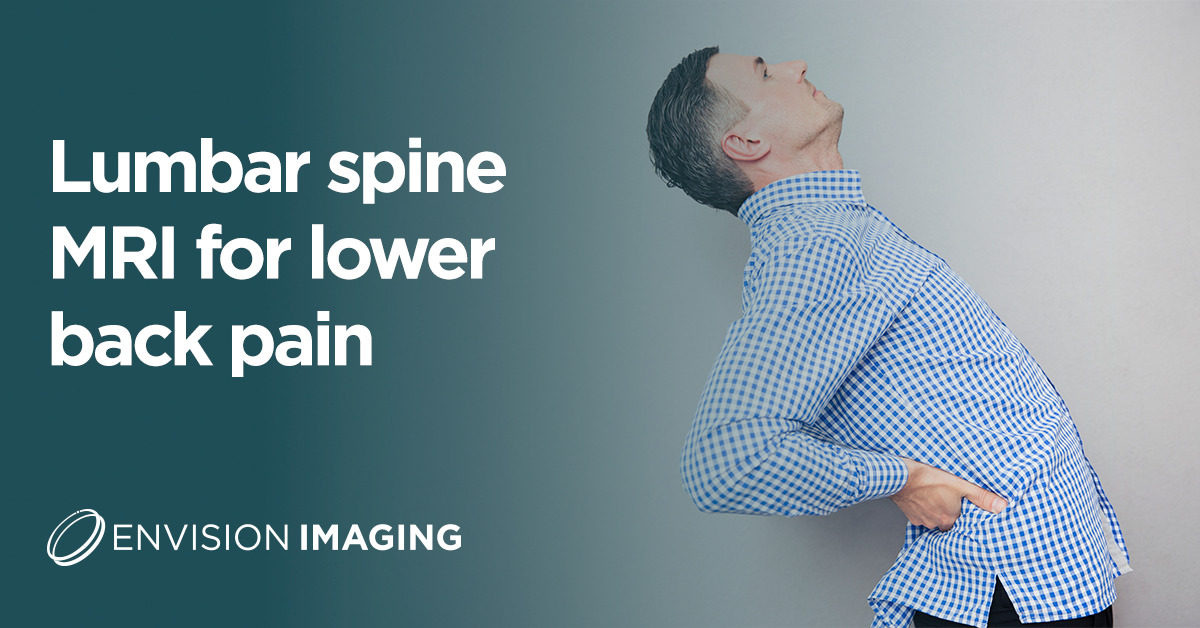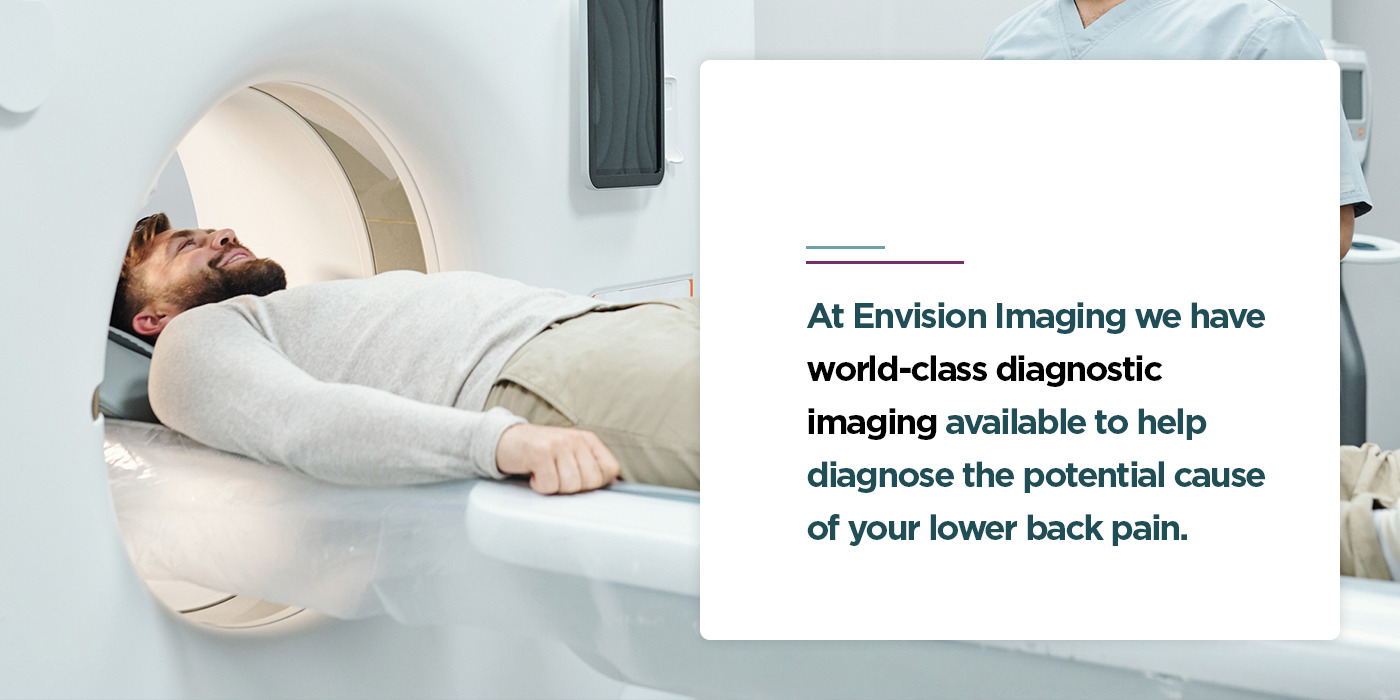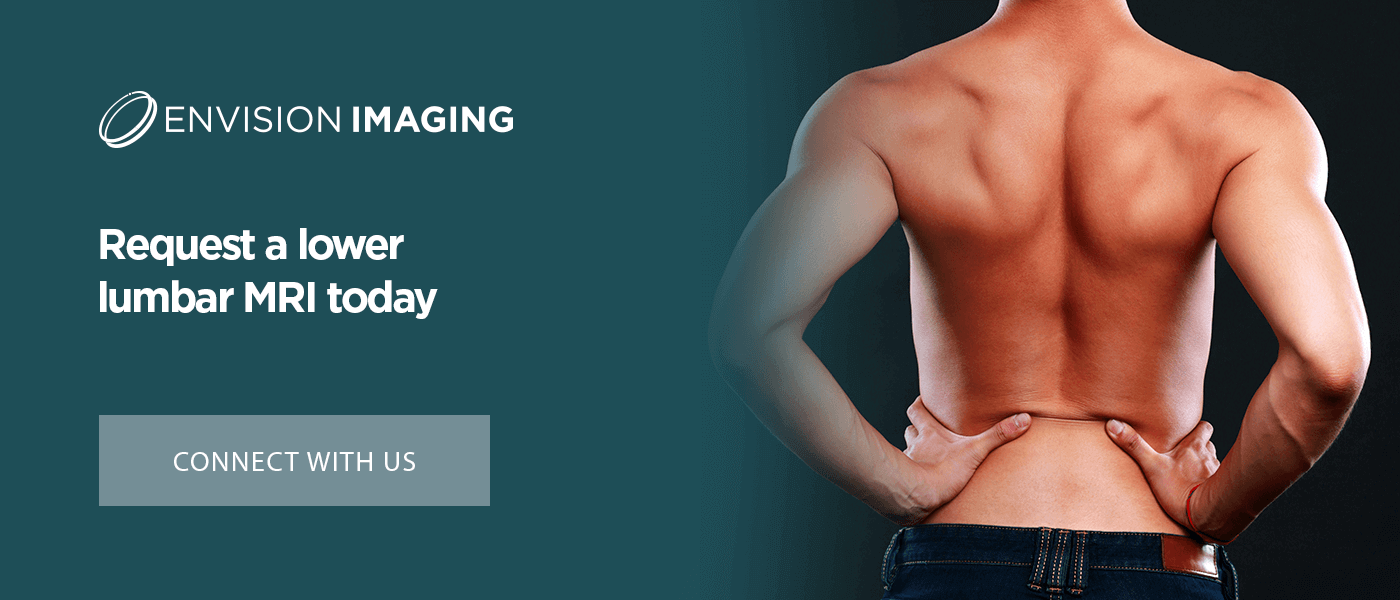Lumbar Spine MRI for Lower Back Pain
Back pain is a common condition among individuals of all ages. While this pain sometimes goes away on its own, there are times it may persist or worsen, even after rest or taking over-the-counter medication.
If lower back pain makes it difficult to go about your daily tasks and responsibilities, it’s time to make an appointment with your healthcare provider. They’ll take a closer look at what’s going on with your lower back and may perform a lumbar spine MRI to see if your pain is related to the condition.
Here at Envision Imaging, our team of experienced, compassionate technologists will provide you with the diagnostic imaging needed to diagnose the cause of your pain and help you regain your quality of life.
Common causes of lower back pain
Lower back pain can have many different causes, ranging from general muscle soreness to more serious medical conditions. Most of the time, lower back pain is nothing to be concerned about, but it is worth getting it checked out if you’ve had it for an extended period and can’t find relief.
Some of the most common causes include:
- Disk problems: There are disks that separate the vertebrae. Issues with these disks, like degenerative disk disease or a herniated disk, can cause pain in the lower back. Degenerative disk disease occurs when anything from repetitive motions to post-joint trauma causes inflammation and structural joint damage. A herniated disk can happen from incorrect posture when lifting heavy objects or result from an accident.
- Osteoarthritis: Osteoarthritis is a type of degenerative joint disease. It is the most common type of arthritis, resulting when the joints start to break down, causing stiffness, achiness or pain.
- Sciatica: Nerve pain, or sciatica, can be felt in the lower back and in the hips and buttocks. The pain and numbness results from bone overgrowth or a herniated disk.
- Sprains or strains: A lower back sprain happens when the ligaments are torn from their attachments, while a strain happens when the muscle fibers are stretched or torn. These types of injuries can happen from overuse, accidents or injuries.
- Spinal Stenosis: Over time, wear and tear can lead to spinal stenosis, a degenerative condition that causes the spinal canal to narrow and put pressure on the spinal nerves.
It’s important to receive a diagnosis because there are times when lower back pain could be the result of a more serious medical condition. This could be the case if you have a history of cancer or experience symptoms like:
- Fever
- Difficulty passing or controlling urine or stools
- Numbness or weakness in your legs
- Difficulty balancing or walking
MRI for lower back pain
With a lumbar magnetic resonance imaging (MRI) scan, a technologist can detect many different conditions. An MRI of the lumbar spine produces detailed images of your lower spine, including specific issues with the disks, nerves, soft tissues and bones.
These machines rely on advanced technology that helps healthcare providers check the anatomy of the spine and see if there’s any injury. Your healthcare team can view your spine’s alignment and whether you may have compressed nerves or spinal cord compression.
At Envision Imaging, we have world-class diagnostic imaging available to help diagnose the potential cause of your lower back pain. We use the highest quality MRI scans to take a close look at your spinal anatomy, seeing if there is anything abnormal that could be caused by:
- Bone infection
- Spinal tumor
- Injury to the ligament, bones or spinal cord
- Degenerative changes
- Disk inflammation
- Narrowing of the spinal column
- Spinal cord abscess or injury
- Issues with intervertebral disks
- Fractures from osteoporosis
These results, along with any other physical symptoms, can help your healthcare provider come up with a diagnosis and treatment plan.
What to expect during an MRI of your lower back
An MRI relies on proton resonance technology to obtain detailed images of your lower back. Specifically, it provides a technologist with a better look at soft tissue cross-sectional representations of the spine as well as soft tissues, muscles and organs.
Unlike other forms of imaging, such as a CAT scan, an MRI doesn’t use or expose you to any radiation. Because an MRI is noninvasive, you won’t feel anything at all during the procedure.
Before your MRI
Before your lower lumbar MRI, you will fill out a screening to let us know about any health risks that could potentially interfere with the procedure.
Once a technologist has reviewed your screening, you will change into medical scrubs (top and pants) or a hospital gown and remove any metallic objects like jewelry, body piercings and hearing aids. We provide lockers so you can safely secure these items during your appointment.
During your MRI
One of our technologists will help you lie down and get comfortable on the examination table. This table is designed to slide into the tunnel-like MRI machine. You may slide in either head- or feet-first. While the machine captures images of your lower back, you’ll hear some banging or knocking sounds.
The procedure is completely pain-free. You’ll just need to lie as still as possible to avoid blurring any of the images. You’ll be able to talk to your technologist during this time or listen to music.
Typically, the entire procedure takes about 30 to 60 minutes. If your exam requires contrast, it may take a little longer. Contrast dye is usually inserted through an IV. While allergic reactions aren’t common, be sure to let your intake team and technologist know if you have kidney problems that need dialysis because the dye could be harmful to those with some conditions.
We’ll help you stay calm and comfortable throughout the entire procedure. Patients are typically welcome to have a family member with them. We also have the option to sedate if patients are especially anxious about the procedure.
After your MRI
Once your MRI is complete, you’ll be able to go back to your day. There’s no recovery time or restrictions unless you took medication to relax or were sedated. The technologist will let you know when to expect results.
Request a lower lumbar MRI today
At Envision Imaging, we are committed to combining the latest in imaging technology with compassionate care. If you’ve been suffering from lower back pain, our world-class radiologists can help you receive accurate results to help get you started on the path to recovery.
We have locations in Texas, Oklahoma, Louisiana and Colorado and offer flexible scheduling to meet your needs. We invite you to request a lower lumbar MRI today to get started.
Linked sources:




